Creating the Perfect Hummingbird Nectar: Tips and Tricks for DIY Feeders
Introduction
Few sights delight outdoor enthusiasts as much as the fluttering, iridescent wings of hummingbirds. These tiny, energetic creatures not only add vibrancy to gardens but also play a critical role in pollination. Attracting hummingbirds to your yard can provide hours of observation and contribute to their survival, especially during migration periods. Central to inviting these enchanting birds is creating the perfect hummingbird nectar and maintaining clean, well-placed feeders. Let’s dive into how you can prepare, maintain, and optimize your hummingbird feeders for the best experience.
The Basic Nectar Recipe
The secret to attracting hummingbirds lies in replicating the natural sweetness they seek from flowers. The best recipe mirrors the sugar content in floral nectar: 1 part white granulated sugar to 4 parts water.
- Exact measurements: For example, use 1 cup of water to 1/4 cup of sugar.
- Water type: Plain tap water is generally sufficient, but you can use purified water if you prefer.
- Methods for dissolving sugar quickly: Stirring the mixture thoroughly helps, especially if you use warm water to speed up the process. Alternatively, a Kitchen Aid mixer can make short work of dissolving the sugar, ensuring no granules remain.
Best Practices for Preparation
When making nectar, it’s important to consider the various methods of preparation and storage to keep the mixture safe and fresh.
- Boiling vs. Not Boiling: Boiling the water can help remove impurities and disinfect the nectar. However, this step is optional if you use clean water. If you do boil, let the mixture cool before filling the feeders. Warm or room temperature water is equally effective for quick preparation without boiling.
- Storage tips: Once prepared, refrigerate the nectar to extend its shelf life. Refrigeration effects on nectar shelf life include maintaining sugar stability for up to one week, ensuring it remains fresh and safe for hummingbirds.
Safety Considerations
Hummingbirds are delicate creatures, and using the wrong ingredients can harm them.
- Use Only Plain White Granulated Sugar: Avoid brown sugar, powdered sugar, honey, or artificial sweeteners. These substances can create harmful nectar additives for hummingbirds, potentially leading to fungal infections and other health issues.
- Additive Dangers: Popular myths suggest adding dyes to attract hummingbirds. However, such dyes, especially red food coloring, can be detrimental. Hummingbirds are attracted to the bright colors of feeders themselves, making the use of dyes unnecessary and potentially toxic.
Importance of Regular Maintenance
Maintaining a clean feeder is crucial for the health and well-being of hummingbirds.
- Cleaning Frequency: Feeders should be cleaned thoroughly at least once a week, more frequently in warmer weather. This ensures that mold and bacteria do not develop. Frequency of nectar replacement in warm weather should be every other day to prevent spoilage.
- Feeder Cleaning Tips for Preventing Mold: Use a brush to scrub the feeder with a mixture of soap and water, followed by a soak in a diluted bleach solution (1 part bleach to 9 parts water). Rinse thoroughly to remove any bleach residue and allow the feeder to dry completely before refilling.
Common Mistakes to Avoid
To ensure a healthy feeding environment, steer clear of these common errors.
- Myths About Dyes and Store-Bought Mixes: Many believe that red-colored syrup mixes are necessary. This is a misconception. The use of natural, homemade nectar is safer and equally attractive to hummingbirds.
- Feeder Design Issues: Problems like attracting bees can often be attributed to the feeder design rather than the nectar itself. Choosing feeders that minimize spillage and restrict bee access can help mitigate this issue.
Tips for Successful Attracting and Feeding
The location and maintenance of feeders are just as important as the nectar itself.
- Optimal Placement for Hummingbird Feeders: Place feeders in a quiet, shaded area to protect the nectar from heating and spoiling quickly. The optimal placement for hummingbird feeders is about 10 to 15 feet from trees, shrubs, or other cover. This not only makes the area safer but also gives you an excellent viewing spot.
- Patience and Consistency: It might take time for hummingbirds to discover new feeders. Being patient and maintaining a consistent feeding schedule will eventually yield results.
Conclusion
Creating the perfect hummingbird nectar and maintaining your feeders doesn’t have to be complicated. By using a precise 1:4 ratio of white granulated sugar to water, choosing the right preparation methods, and adhering to stringent cleaning routines, you can create a safe, inviting environment for these marvelous birds. The rewards of observing hummingbirds in your backyard as they hover and feed are truly unparalleled. We encourage you to share your experiences and additional tips, fostering a community that celebrates and supports these incredible creatures.

